Log in or create new account to save this product to your wishlist.
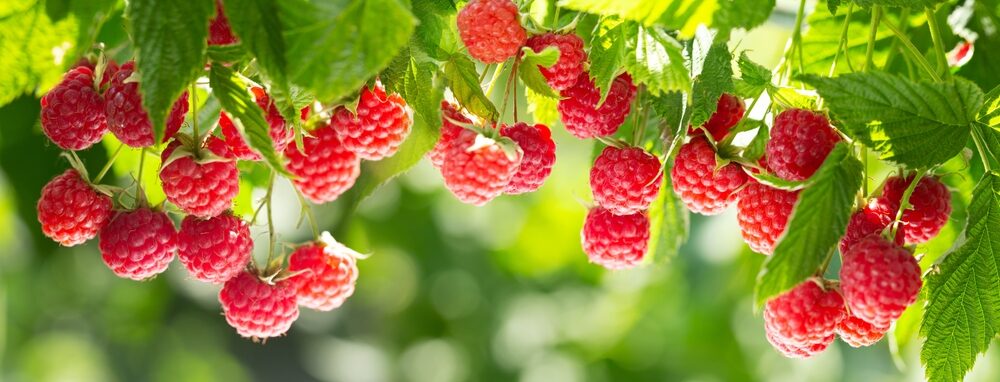
How to Grow and Care for Raspberry Plants
Start your raspberry garden with our guide on planting and caring for raspberry plants. Grow fresh raspberries at home effortlessly.
🌱 All important maintenance moments for your lawn during the year. Leave your email and we will send you the lawn calendar for free.
Enter your email
Receive the lawn calendar in the mail
Enjoy a green lawn all year round!

- Order by 2PM = shipped today
- 250.000+ satisfied customers!
- 60 day satisfaction guarantee
Do you love that delightful tang of garden-fresh raspberries? Maybe you find good quality raspberries are difficult to find in the supermarkets? Well, luckily, growing raspberry plants in your garden is pretty straightforward — all you need is space, a little time, and some patience.
- What are raspberry plants?
- Choosing the right variety of raspberry plant
- When and where to plant raspberry plants
- Growing raspberry plants in containers
- Raspberry plant care
- Pruning raspberry plants
- Protecting raspberry plants from pests and diseases
- Harvesting raspberries
- Storing and using raspberries
- Additional tips for growing raspberry plants
- FAQs
Indeed, raspberry plants are a delightful addition to any garden, offering juicy and flavorful berries that can be enjoyed fresh or used in inspiring culinary creations. So, whether you have a large backyard or a small balcony, you can successfully grow raspberry plants to enjoy a bountiful harvest.
In this comprehensive guide, we’ll cover everything you need to know about growing and caring for raspberry plants, from choosing the right variety to pruning and harvesting.
So, let’s dive in and explore the wonderful world of raspberry plants!
What are raspberry plants?
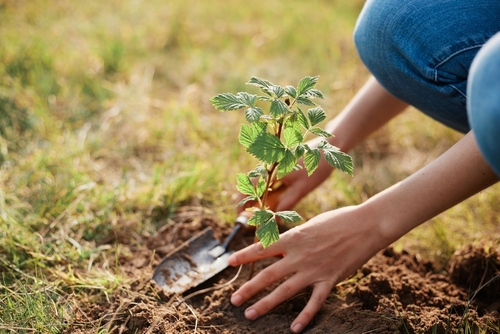
Raspberry plants belong to the Rubus genus and are part of the Rosaceae family.
These versatile plants produce delicious berries and beautiful white flowers that add charm to any garden, attracting pollinators like bees and butterflies all through spring.
There are two main varieties of raspberry bushes: summer-bearing and autumn-bearing.
- Summer-bearing raspberries produce a single fruit crop in late summer on the previous year’s growth. They are known for their tall and vigorous growth, often requiring staking for support.
- Autumn-bearing raspberries, also known as everbearing raspberries, produce fruit on new canes. They offer the advantage of two harvests, one in late summer and another in the following year
Do I need to grow raspberry plants in pairs?
Raspberry plants are self-fertile, meaning you only need one plant to produce fruit.
However, they benefit from pollination by bees, which helps increase fruit production.
Choosing the right variety of raspberry plant
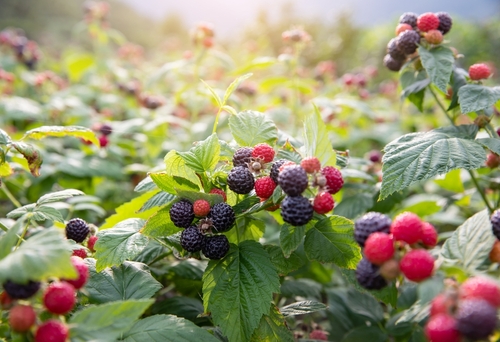
When choosing the right variety of raspberry plants, you have many options to suit your preferences and growing conditions. So, whether you have a sunny spot or an area in partial shade, there’s a raspberry plant for you.
Varieties differ in terms of fruiting season, flavour, size, and disease resistance.
Here are some popular raspberry varieties to consider:
- Summer-bearing varieties: ‘Glen Ample’, ‘Malling Jewel’, ‘Glen Magna’
- Fall-bearing varieties: ‘Autumn Bliss’, ‘Joan J’, ‘All Gold’
It’s important to note that certain varieties have received the RHS Award of Garden Merit (AGM), indicating their excellent performance in trials. These varieties are more likely to provide reliable crops.
Additionally, you can visit RHS gardens to see different raspberry varieties and gain valuable insights from expert growers.
When and where to plant raspberry plants
The timing and location of planting are crucial for the success of your raspberry plants.
Plant your raspberry canes in either autumn or spring, depending on your climate and the availability of plants.
Ideally, choose well-established one-year-old canes from reputable nurseries or garden centres.
How to plant your raspberry bush:
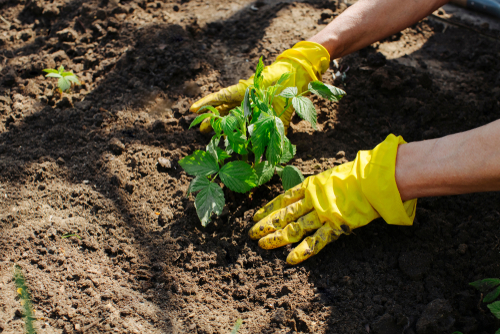
- Soak the bare roots of your raspberry canes in water for about an hour before planting. This helps ensure they are well-hydrated and ready for growth.
- Prepare the planting site by selecting a location that receives full sun or partial shade. Raspberry plants tolerate shade but produce better fruit in sunny spots. Ensure the soil is fertile, well-drained, and slightly acidic (pH 6.5-6.7). Find out how to analyse your soil’s acidity.
- Clear weeds and dig in well-rotted manure or compost to improve soil fertility. Aim for at least one bucket of manure or high-quality compost per square metre.
- Install supports, such as posts and horizontal wires, before planting, especially if you’re growing summer-bearing raspberries. This will provide the necessary structure for the canes to grow and bear fruit.
How to space your raspberry canes
When planting raspberry canes, space them approximately 45cm (18in) apart, with 1.8m (6ft) between rows. And ensure the first roots are no more than 5cm (2in) below the soil surface.
After planting, apply a mulch layer, such as garden compost or leaf mould, to retain moisture and suppress weed growth.
Growing raspberry plants in containers
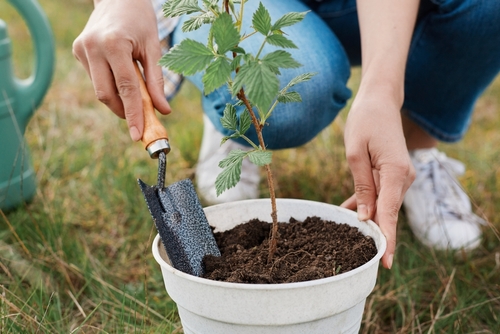
If space is limited, you can still enjoy the delights of raspberry plants by growing them in containers.
In this case, select compact varieties well-suited to container gardening, such as ‘Ruby Beauty’ for autumn-bearing raspberries or ‘Glen Ample’ for summer-bearing raspberries.
How to successfully grow raspberries in pots:
- Select a container at least 38cm (15in) wide to provide enough space for the roots to spread.
- Fill the container with 80% peat-free multi-purpose compost and 20% peat-free soil-based potting compost.
- Plant a single raspberry cane in the centre of the container at the same level it was previously growing.
- Insert bamboo canes for support and tie the raspberry stems to them as they grow.
Remember: provide water and regular feeding with a general-purpose liquid fertiliser during the growing season.
Raspberry plant care
Proper care and maintenance are paramount to protect your plant’s productivity and vitality.
Here are some essential care tips to follow throughout the growing season:
Watering your raspberry bushes
Raspberry plants require regular watering, especially during dry spells.
Aim to keep the soil consistently moist. However, avoid overwatering, which can lead to soggy conditions and potential root rot. Be extra cautious about overwatering if you have heavy clay soil prone to waterlogging.
Consider drip irrigation or a leaky hose system for watering at ground level.
Mulching your raspberries
Apply a thick layer of mulch around your raspberry plants in early spring after feeding.
This helps retain soil moisture, suppress weeds, and provide essential nutrients as the mulch breaks down.
Feeding your plants
Feed your raspberry plants in early spring using a high-potassium general fertiliser, such as fish, blood, and bonemeal.
Scatter the fertiliser around the plant’s base according to the recommended dosage.
Supplement with additional nitrogen or poultry manure pellets if your plants are growing weakly.
Supporting your raspberry plants
Summer-bearing raspberries require a support system, such as posts and horizontal wires, to prevent the canes from breaking or bowing under the weight of the fruit.
Tie the canes to the support wires as they grow, ensuring proper spacing between canes.
Pruning raspberry plants

Like most garden plants, pruning keeps your raspberry bush healthy, which promotes better fruit production while managing the overall growth of the plant.
Pruning methods differ depending on whether you’re growing summer-bearing or autumn-bearing raspberries.
Pruning summer-bearing raspberries
- After planting, prune all canes down to 25cm (10in) tall, except for summer-fruiting raspberries bought as “long canes.”
- In subsequent years, remove all canes that have fruited after harvesting. These canes will not produce fruit again.
- Tie the new cane growth to the support system, ensuring proper spacing between canes.
- Prune weak and overcrowded canes to maintain good airflow and sunlight penetration.
Pruning autumn-bearing raspberries
- In late winter or early spring, cut all canes to the ground. This allows the new canes to grow and produce a late summer/early autumn crop.
- Alternatively, you can adopt a different pruning technique known as “tip-pruning”. Cut back the tips of the canes in late winter, leaving around 12 inches above ground level. This will result in a larger late crop.
Regular pruning controls the size of your raspberry plants, promotes better air circulation, and prevents the spread of diseases.
Protecting raspberry plants from pests and diseases
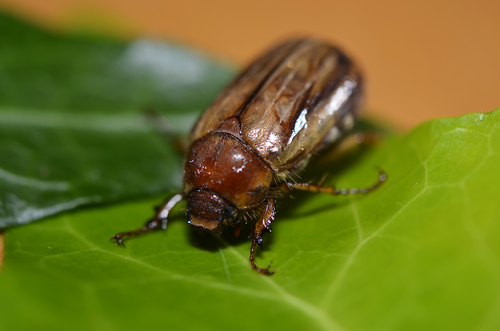
While raspberry plants are relatively hardy, they can be susceptible to some pests and diseases.
Here are some common issues and preventive measures to keep your plants healthy:
Pests affecting raspberry bushes
- Birds: Protect your raspberry plants from birds by using netting or bird scare devices. However, check the netting regularly to prevent any wildlife from becoming trapped.
- Shield bugs: Green shield bugs and other shield bugs may appear on raspberry plants, but they are generally harmless, causing insignificant damage.
Potential raspberry plant diseases
- Powdery mildew: To prevent powdery mildew, choose disease-resistant varieties, provide adequate spacing between plants for good air circulation, and remove old fruiting canes after harvest.
- Raspberry rust: This disease causes rusty dots on the leaves. Clean up fallen fruits and dead leaves around the plants to control raspberry rust.
Harvesting raspberries
The moment you’ve been waiting for has arrived – it’s time to harvest your raspberries!
Harvesting raspberries at the peak of ripeness ensures the best flavour and texture.
So, here are some tips for successful raspberry harvesting:
- Timing: Harvest your raspberries only when fully coloured and detach easily from the plant. The berries should be firm and plump.
- Be gentle: Tug gently on the fruit. It should detach easily from the stem. Avoid pulling too hard – ripe berries will come off effortlessly.
- Harvest frequently: Raspberries ripen quickly, so check your plants every few days during the harvest season. This ensures that you pick the berries at their peak freshness.
- Use the fruits immediately or store them: Raspberries have a short shelf life, so it’s best to eat them immediately or store them properly. If you’re not consuming them immediately, store them in the refrigerator for up to three days or freeze them for longer preservation.
Storing and using raspberries
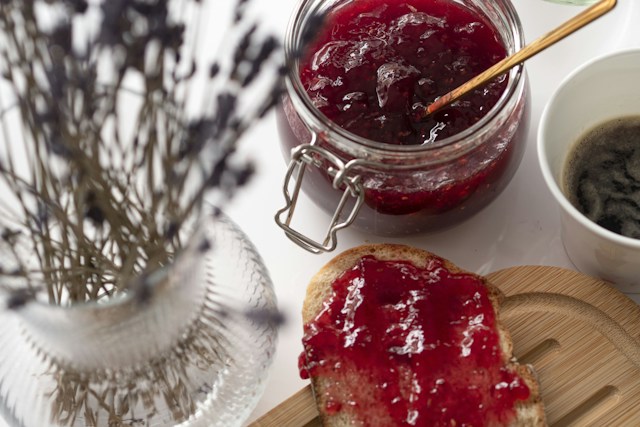
While freshly picked raspberries are undeniably delicious, there are various ways to store and use your harvest.
Here are some suggestions:
- Refrigeration: If you plan to consume your raspberries within a few days, store them in the refrigerator in a single layer. Avoid washing them until you’re ready to eat them to prevent moisture-related mould and decay.
- Freezing: Raspberries freeze exceptionally well and can be used in smoothies, baked goods, or enjoyed as a frozen treat. To freeze your raspberries, spread them out on a tray in a single layer and place them in the freezer until firm. Then, transfer them to a freezer bag or airtight container for longer-term storage.
- As an ingredient: Raspberries are versatile and have many culinary uses, such as in jams, jellies, pies, tarts, sauces, and even beverages like smoothies and cocktails. Let your creativity flow, and experiment with different recipes to savour the delightful flavours of raspberries.
Additional tips for growing raspberry plants
To further enhance your success in growing raspberry plants, here are some additional tips to keep in mind:
- Garden hygiene: Maintain your garden’s hygiene by removing fallen fruits, dead leaves, and other debris. This helps prevent pests and diseases.
- Winter Protection: Provide winter protection for your raspberry plants by covering them with straw or mulch to insulate the roots and protect against frost damage.
By following these additional tips, you can optimise the growth and productivity of your raspberry plants, ensuring a thriving harvest year after year.
FAQs
To plant raspberry plants, prepare the soil in a sunny location with well-draining soil. Dig a hole twice the size of the root ball, placing the plant at the same depth as it was in the container. Then, water regularly, provide support canes, and mulch to retain moisture. Prune your canes to encourage growth and fruit production.
The best month to plant raspberries is either early spring, preferably in March, or late autumn, depending on your climate. In cooler regions, planting in early spring allows the plants to establish before summer. In warmer climates, autumn planting takes advantage of milder temperatures, helping the plants develop roots before the onset of winter.
The best place to plant raspberries is in a sunny location with rich, well-draining soil. Raspberries thrive in full sunlight, so choose a spot that enjoys at least 6-8 hours of sunlight per day.
Any questions?
Growing and caring for raspberry plants can be a rewarding and fruitful experience. I hope we’ve provided all the questions you might have about growing raspberries in your garden, but if you have any questions, don’t hesitate to drop us an email.
Or check out our Help & Advice section for expert guides to everything lawn and garden-related.
Happy gardening!
-
Orchids: A Complete Guide on How to Care for ThemWant to give your orchid the best possible care? Discover essential tips from placement to watering and pruning. Learn everything you need to know!Read more
-
Growing Wisteria Made Simple: From Planting to Perfect BloomsWith blossoms like a purple waterfall, Wisteria sets an almost magical and colourful mood. If you want to grow this beauty in your garden, you’ll need a bit of patience. Don’t worry, it will most definitely pay off.Read more
-
How to Build a DIY Greenhouse: A Practical Guide for Smart SpendersImagine extending your growing season throughout the year, nurturing tender plants regardless of the weather, and creating a personal garden sanctuary. This is precisely what a DIY greenhouse offers you. Let’s learn how to build one.Read more
-
How to Grow Eucalyptus in British GardensWith a little love and care, eucalyptus trees can thrive in English gardens. Since they don’t germinate well without proper help, there are not considered invasive. So, there is no reason not to plant them if you enjoy their looks.Read more
-
Transform Your Garden with All-Year-Round Flowering PlantsDid you know you can enjoy blooming flowers even in January? With the right selection of all year round plants, there’s no need to wait until spring to add some colour to your garden.Read more
-
How to Create a Butterfly Garden: A Simple Guide for British GardensThe UK's butterfly population includes 59 different species. These beautiful winged creatures face a steady decline because of habitat loss, pollution and changing weather patterns. Your garden can become a vital link between nature reserves and natural habitats. Let’s explore how.Read more
-
Volcanic Rock Dust for Your Garden—Application and TipsDid you know that volcanic rock dust is a brilliant organic soil improver? This article explains exactly what it's good for and how to use it properly.Read more
-
How to Use Landscape Fabric ProperlyIf weeds or erosion in your garden are troubling you, landscape fabric might be the solution. We’ll explain how and when to use it properly, just keep on reading.Read more
Leave a comment
Your answer will be displayed on the site and the interested party will be notified by email.
Leave a comment
Have a question or want to share your experience? Leave us a comment.

- Order by 2PM = shipped today
- 250.000+ satisfied customers!
- 60 day satisfaction guarantee

- Order by 2PM = shipped today
- 250.000+ satisfied customers!
- 60 day satisfaction guarantee

🌱 All important maintenance moments for your lawn during the year. Leave your email and we will send you the lawn calendar for free.
Enter your email
Receive the lawn calendar in the mail
Enjoy a green lawn all year round!






















Comments (0)
There are no comments yet. Well then, what are you waiting for to
Be the first to write your comment!inaugurate this pretty page?
Do you have some comments?